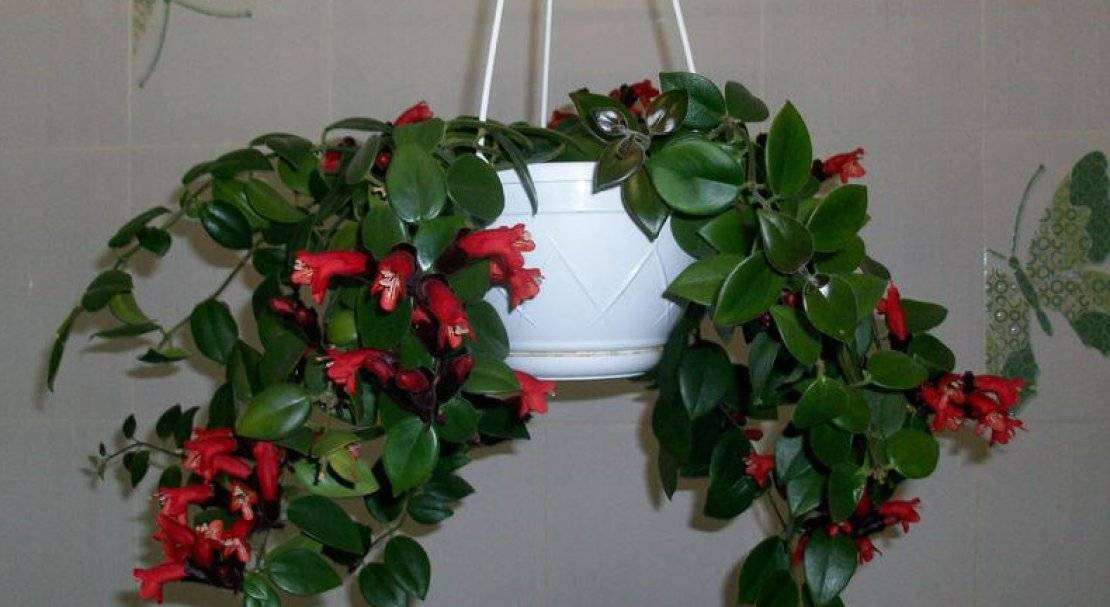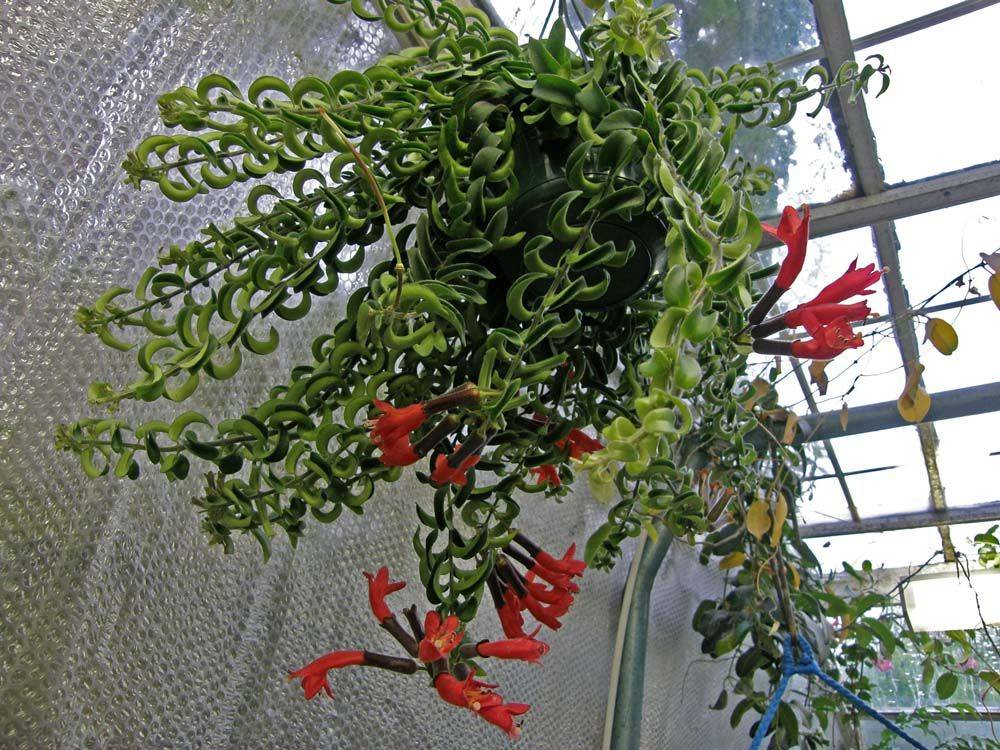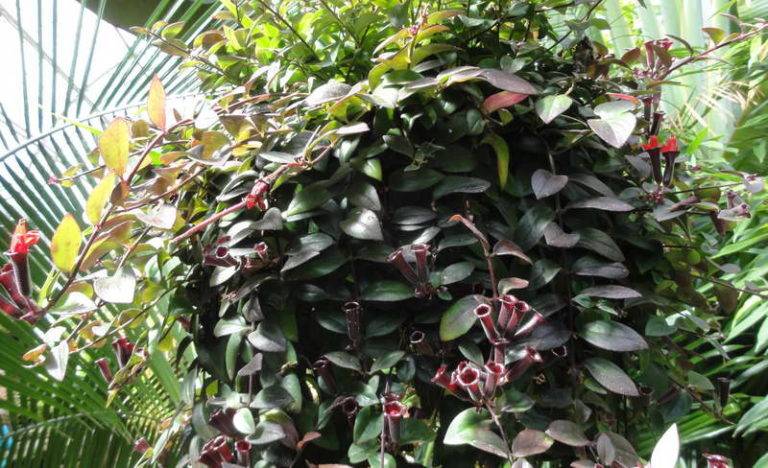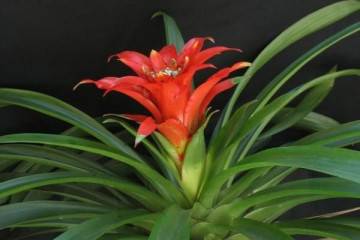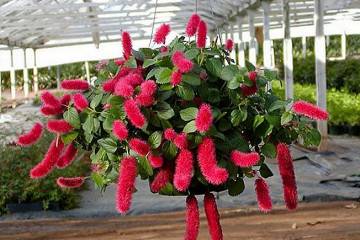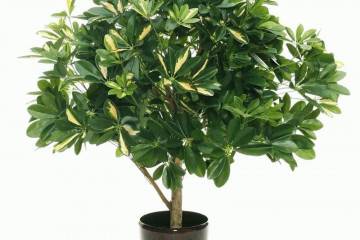Aeschinanthus flower - home care and reproduction
Content:
It is a great honor for a florist to have a rare plant in the collection. One of them is the escinanthus flower. Only experienced and patient flora lovers undertake to cultivate such a miracle of nature.
What does it look like, which family it belongs to
This is an unusual perennial plant with an original flower shape and spectacular bright green foliage. The leaf plates are fleshy, satin, with short petioles. 4 cm wide, 10 cm long. Ovate-pointed. They grow in pairs, opposite.
The flowers are beautiful, orange or fiery red. They appear at the tips of branches, form racemose inflorescences. The flower at the base is lemon-colored, towards the edges turns into carrot-red. When fully opened, a white ovary tube is found inside.
The history of the appearance, the birthplace of the flower
In the wild, Aeschynanthuc grows in the forests of Southeast Asia near water bodies, waterfalls. This is an epiphytic culture, that is, it lives on tree trunks. However, she does not feed on the sap of the tree, but uses it as a support.
The flower was first transferred to greenhouses, where they created conditions close to natural ones. Only much later they began to cultivate in pots for home decoration.
The flower is capricious to care for. But it lends itself to the care and attention of flower growers.
Features of home care
Aeschinanthus at home needs systemic care.
Temperature regime
The plant does not tolerate temperature changes, drafts. Suitable t is 20-25 ° C. In the fall, the pot is moved to a cool, well-lit room with a temperature of 15-18 ° C. At temperatures below this, the tropical guest loses its foliage. When buds begin to form at the end of winter, the temperature is gradually raised.
Lighting
A well-lit place is chosen for the flower. On the northern side, where there is little light, the exotic will not bloom. Aeschinanthus is shaded on the southern windowsill. The room is ventilated, the flower is protected from drafts.
Watering
Moisten the soil with settled soft water when the earth dries out a few centimeters. The moisture is drained from the pallet. The drainage is supposed to be good so that the water does not stagnate. The water temperature is room temperature.
Spraying
Spray only in the summer 1-2 times a day. The liquid is lukewarm. Leaves are sprayed, there is no need to spray on the flowers. Rarely arrange a warm shower.
Do not spray in cold weather.
Humidity
There is enough water in the thick leaves of the exotic, so it is not afraid of rooms with low humidity. But if it is too hot in summer, then the plant is helped like this: wet expanded clay is poured into the pallet, a flowerpot with the culture is placed in it.
Priming
The plant requires light, loose soil that can absorb water vapor from the air. Buy universal, or prepare themselves: two parts of peat and leafy soil, and one part of peat moss and sand.
Top dressing
Fertilize often, but little by little.Take a remedy for flowering crops. For each feeding, use half of the recommended dose. Aeschinanthus indoor flower is fed once a week.
Support
The tropicana does not need support, she easily lowers the branches down. But this is the case with the ampelous variety.
There are species that form a bush. Then the support in the form of a spiral or arch is placed in a flowerpot as soon as the escinanthus is planted. The shoots do not wrap around the support - they are tied to the rungs.
When and how it blooms
You can admire the flowering from spring to late autumn. The flowers bloom in small clusters at the ends of the shoots. Wrong, with an original asymmetrical rim. It seems to be only half open. Inside there is a long, up to 10 cm, curved tube. The graceful double-lipped limb of the outer petals makes the flower unique.
Blooms profusely, throughout the warm period, from June to October. Flowering is characterized by the constancy of the number of inflorescences. But the care and conditions must be perfect.
Pruning
To make the tropical guest look beautiful, pinch the shoots on the 2 top leaves. Old, running ahead branches are mercilessly pruned.
How does it multiply
Aeschinanthus propagation is carried out in several ways known to flower growers:
- Cuttings. The apical stems are cut to the buds with 5-6 internodes. remove the bottom sheets, put in water. This is rooting without land. In another case, cuttings are planted in a mixture of sand and peat (1: 1), covered with polyethylene. Provide heating from below.
- Sheet. A healthy leaf with a bud is cut off. Treated with fungicide, charcoal. It is dried for 2-3 days, planted in wet sand, covered with glass, film. Allow to take root, transplant, sprinkle with sand.
- Seeds. Collect the smallest, like dust, seeds from seed pods on a sheet of paper. Sow evenly on the soil, cover with glass. Water is supplied through a pallet. Seedlings are transplanted into small containers. Only professionals can propagate by seeds.
Transfer
Culture grows in cramped containers. When roots appear from the drainage holes, the plant is transplanted using the transshipment method. Choose a container 3 cm larger than the previous one. Drainage is poured into the bottom by 3 cm. Take a suitable substrate, disinfect with a fungicide. The flower is taken out of the old flowerpot along with the earth. When planting in a new container, add soil. Watered, put in partial shade.
Possible growing problems
Exotic escinanthus care requires careful attention. Therefore, a beginner florist often faces problems.
Why do leaves fall
In hot weather, the reason for the loss of leaves is the dry land, there is not enough moisture in the air. Watering mode is restored.
To understand why the plant dropped its crown in winter, first of all, they look at the thermometer. Low air temperature in the room can destroy the flower. Transfer to a warmer place.
Diseases
Good care forms the plant's immunity to diseases. But violation of agricultural technology leads to diseases:
- Powdery mildew. A fungal infection occurs when the plants are too flooded, the earthen ball is excessively wet. If at the same time the temperature is low, then the culture becomes sick. First, the diseased areas are cut out. Then it is treated with a fungicide. If there is no effect, the plant is destroyed.
- Gray rot. It appears in brown spots on the leaves. They lose their elasticity. Also a fungal disease. It spreads quickly, the plant dies. They are treated with Topaz, Fitosporin.
Pests
Pests annoy the tropical beauty:
- Aphid. Insect parasite. It is activated in the spring and summer. It sucks the juices out of the leaves. The leaf shrivels, the plant stops growing.They are fighting by means of Aktar, Kinmiks.
- Shield. When round or oval plaques measuring 2-7 mm are found on the leaves and shoots, they talk about the defeat of the culture by the scabbard. The plaques seem to be adhered to the leaves. This is a pest dangerous for the plant - it feeds on its juices. They are treated with an insecticidal agent.
- Mealybug. A small insect that looks like a tiny wood louse. Creates large colonies, and big problems for home flowers. Treat with soapy water.
Other problems
If light brown spots appear on the leaves, the water may be too cold for irrigation.
Views
In home greenhouses, 15 species of aeschinanthus are grown. In wildlife from more than 200. In honor of gardeners the following species.
Marble
Prized for its beautiful leaves. The outer surface of the marble escinanthus leaf is covered with white wavy streaks. Inside chestnut or red-brown color scheme.
Beautiful
Favorite flower of home growers. Shrub with half-meter shoots. Eschinanthus Beautiful home care receives the most thorough. The plant is spectacular, lives up to its name. Leaves are dense, emerald green. Flowers are collected in bunches of 10-12 pieces. The rim at the end resembles a blade. Divided into 5 parts, each folds outward, has a bright red spot in the shape of a crescent.
Variety Fine
It bears a resemblance to the Beautiful. But the Beautiful Aeschinanthus differs in the shape of the leaf - it is smaller. A red border runs along the edge. The stems are pale red. A flower of an expressive red hue, pink throat.
Twister
Aeschynanthus Twister is covered with curved leaves of an unusual shape. The epiphyte looks curly. The leaves shine as if waxed. They have a deep green color scheme. Coral-colored flowers grow in the leaf axils. At the ends of the shoots, up to 10 inflorescences also bloom.
Mona lisa
Aeschynanthus Mona Lisa is a flower that even a novice florist undertakes to grow. The plant is easy to care for. It is distinguished by a clearly defined central vein on the leaves. Shoots end in clusters of bright red flowers.
Lobba
Aeschynanthus lobbianus is a native of Java. Flexible and elastic branches of blueberry color are covered with many small oval leaves. Painted with a deep green color scheme with a purple border around the edges. The lower part is almost contrasting - light tobacco color. Brushes are red, two-lipped.
Caroline
Aeschynanthus Karolina grows in hanging pots. Beautifully lowers down large leaves. The bract is colored burgundy, single flowers are scarlet.
Aeschinanthus rocky
A rare variety. Aeschynanthus Skalynyy grows in the wild without soil. Habitat - rocks, mossy stones. The leaves are similar to those of oak. The flowers are purple, of varying color intensity.
Rasta
Aeschynanthus rasta - twisted leaves, purple flowers. The scourge is directed downward.
Firebird
Aeschinanthus Firebird (Zhar Ptitsa) is a lush bush with many inflorescences. Painted in different shades of red.
Jefrolepis
Dzhefrolepis variety is a densely leafy ampelous plant. Shoots fall picturesquely from the pots. Fleshy, glossy leaves. Corollas are tubular, red.
Long-stemmed
Eschinanthus Apple big unusual flower with long stems. The leaves are large, brown-green. On them, like the hand of an artist, a marble pattern is applied. The flowers are amazing green with brown spots.
Aeschinanthus Black Pagoda
Aeschinanthus Black Pagoda is distinguished from other varieties by flowers located along the entire length of the stem. It droops gracefully, there are many shoots. Blooms constantly. The flowers have a wide red stripe.
Aeschinantus the Magnificent
The tropical beauty of Aeschynanthus the Magnificent lies in the flower. A long white tube of the ovary protrudes from the red pharynx. Peduncles at the ends of the shoots are collected in clusters of 6-10 pieces. The branches are long, up to half a meter. There are many small leaves.
The exotic plant Aeschinanthus is demanding and difficult to care for. To admire the riot of colors, they create high-quality agrotechnical conditions: light, air, watering, temperature. Protect from pests and diseases.
